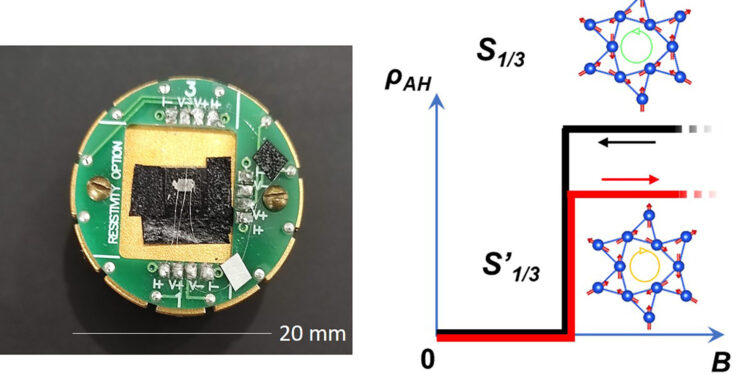Left: HoAgGe single crystal. Right: Anomalous Hall effect as a function of magnetic field B during up and down sweeps (red/black) with right (yellow) and left (green) rotating magnetic moment configurations. Credit: University of Augsburg
Physicists from the University of Augsburg have succeeded in distinguishing chiral orders with similar magnetization but opposite direction of rotation using low-temperature electrical measurements. This is relevant for fundamental research into complex magnets and possible applications of magnetic data storage. The results were published in Natural physics.
Electric currents and magnetic forces are directly related to each other: current-carrying cables create a circular magnetic field and vice versa, a magnetic field deflects electrically charged particles perpendicular to the current and direction of the field. This latter phenomenon is called the “Hall effect” in honor of its inventor Edwin Hall.
The Hall effect is used to probe the electrical and magnetic properties of metals. The “normal Hall effect” allows us to determine the concentration of charger carriers and their mobility while an additional contribution called the “abnormal Hall effect” appears in magnets.
At the Institute of Physics at the University of Augsburg, it was discovered that the anomalous Hall effect could reveal hidden symmetry. “Despite equal magnetization, two states exhibit significantly different anomalous Hall signals, a surprising and striking observation,” explains Philipp Gegenwart, professor of experimental physics.
Magnetic model circulating right and left
The research was carried out with the magnetic metal HoAgGe, which has special magnetic properties discovered four years ago by Professor Gegenwart’s team. The material has a triangular configuration of atomic electron spins of Holmium atoms.
Since it is impossible to simultaneously perform all pairwise interactions on each triangle, a magnetically frustrated state arises. It has several energetically degenerate configurations per triangle and is called Kagome spin ice. The spins are located on the edges of shared triangles resembling woven Japanese “Kagome” baskets. Similar rules that apply to water ice determine the possible configurations of magnetic moments.
Unlike ordinary magnets, the magnetic moments in Kagome’s spin ice are not aligned in one direction but rather obey a complex chiral pattern, that is, with a different direction of rotation. They are created in an applied magnetic field at low temperature and exhibit fractional magnetization plateaus at values of 1/3 and 2/3. The figure above shows two such models with similar energy and 1/3 of the saturation magnetization each.
Possible application for data storage
The study by the research group at the University of Augsburg systematically investigated and analyzed the anomalous Hall effect at low temperatures. Surprisingly, different values of the anomalous Hall effect were found for the two 1/3 magnetization models, visible as red and black curves in the plot of the figure above.
Modeling the data revealed a unique underlying hidden symmetry: the combination of a 180° rotation and a warp inversion is necessary to transform one pattern into another. The conduction electrons scattered by the two different models result in different curvatures of the phase of their wave functions, which leads to a difference in the anomalous Hall effect, despite similar energy and magnetization of the two different models.
More generally, this observation indicates new potential for measurements of the anomalous Hall effect in magnetically frustrated metals, and for the discovery of symmetries and hidden states through electrical measurements. “This may also be of interest with regard to permanent magnetic storage of data on the smallest atomic scale,” says Gegenwart. However, this requires local addressing and selective switching of the direction of rotation of these patterns.
More information:
K. Zhao et al, Discrete degenerations distinguished by the anomalous Hall effect in a metallic kagome ice compound, Natural physics (2024). DOI: 10.1038/s41567-023-02307-w
Provided by the University of Augsburg
Quote: The Hall effect discovers a hidden symmetry in spin ice (February 7, 2024) retrieved on February 7, 2024 from
This document is subject to copyright. Apart from fair use for private study or research purposes, no part may be reproduced without written permission. The content is provided for information only.



